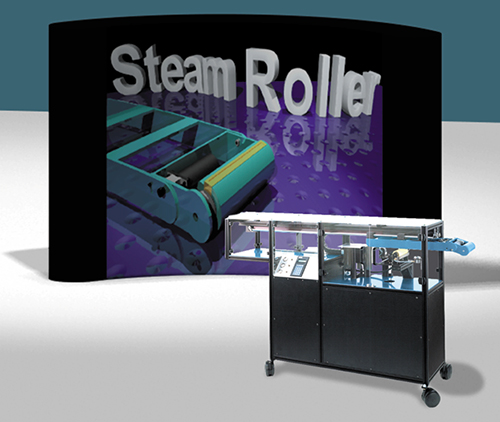Rapid Prototyping
The ability to use ceramic materials for space-based components has helped reduce product development cycles in equipment manufacturing via rapid prototyping.
Accomplishments under NASA Small Business Innovation Research (SBIR) and Small Business Technology Transfer (STTR) contracts have helped enable Javelin, a division of Lone Peak Engineering, Inc., of Salt Lake City, Utah, to become a dominant developer in the advancement of rapid prototyping technologies. The SBIR and STTR efforts were conducted for NASA's Johnson Space Center and Marshall Space Flight Center, respectively.
Using the most advanced systems available today, Javelin has designed one of their most notable developments, the SteamRoller™ System, a rapid prototyping process that produces functional ceramic prototypes directly from computer-generated models. This fully automated ceramic-laminated object manufacturing—CerLAMTM for short—is a process that builds ceramic prototypes layer-by-layer using ceramic sheets. The prototype is built directly from a computer-generated model without any tooling.
Rapid prototyping is an exploding new technology that is evolving within the design and manufacturing industries. This technology makes it possible to fabricate physical parts, without the need for tooling, through the direct conversion of three-dimensional data. Rapid prototyping uses the principles of slicing, layering, and bonding to build the part.
Three-dimensional data is first sliced into cross-sectional planes by a computer. These planes are sent from the computer to the rapid prototyping machine, which builds the part layer-by-layer. The first layer of the part is bonded to a platform or starting base. The shape of the first cross-sectional plane defines the part's geometry. The second layer is bonded to the first and shaped according to the second cross-sectional plane. This process is repeated until the part is complete.
Javelin's SteamRoller™ System couples the CerLAM™ build process to the conventional laminated object manufacturing (LOM) machine. Prior to the SteamRollerTM, the build process was semi-automatic and required an operator to position each ceramic sheet in the LOM machine for lamination and cutting. Recently introduced by Javelin, the commercially available SteamRoller™ System allows both ceramic and metal sheet materials to be rapidly prototyped on the LOM.
Engineered ceramic materials that have been used by Javelin's SteamRoller™-LOM process include: 99.9 percent alumina, zirconia, silicon carbide, aluminum nitride, silicon nitride, aluminum silicates, hydroxyapatite, and various titanates.
The CerLAM™ process gives design and manufacturing engineers a rapid, cost-effective, and flexible option for ceramic prototyping or when small quantities of parts are needed. A companion to the CerLAM process has been developed at Javelin for metal prototypes and tooling as well.
Initially, Lone Peak Engineering, under which Javelin operates, conducted contract research studies. However, the company's focus has shifted to emphasize design, prototyping, and production of industrial components out of engineered models, such as technical ceramics and advanced polymers. Several developmental efforts have been pursued, such as producing erosion resistant parts, corrosion thwarting pumps, laser guides, and automotive seals.
The company has also manufactured the following products: ceramic golf shoe spikes that never flatten; zirconia ceramic-bladed razor blades for microtomes that never rust, corrode, or need sharpening; ceramic turbines with a hardness approaching that of diamonds and a strength equaling the best German steels; and even bioceramic bones prototyped directly from medical data.
SteamRoller™ and CerLAM™ are trademarks of Lone Peak Engineering, Inc.

Javelin's unique SteamRoller™ System provides a rapid prototyping process for making ceramic components.













